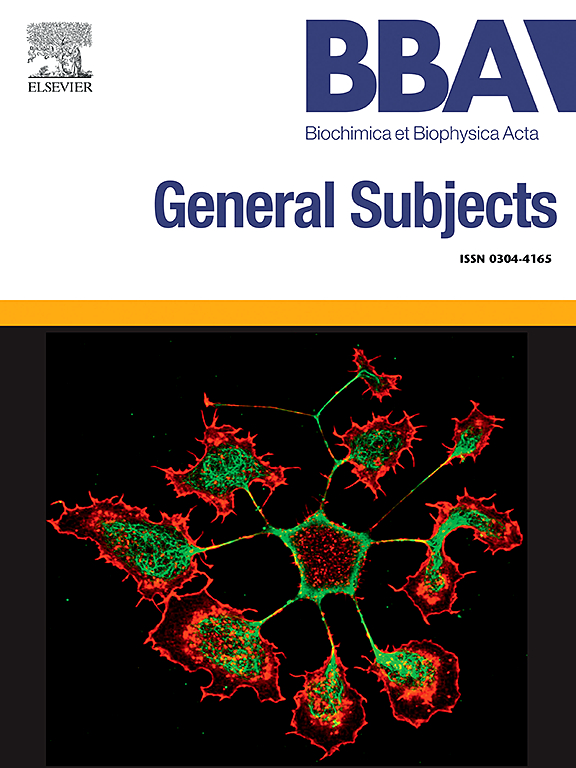Cyanobacterial KdpD modulates in vivo and in vitro activities of a membrane-anchored histidine kinase
IF 2.2
3区 生物学
Q3 BIOCHEMISTRY & MOLECULAR BIOLOGY
Biochimica et biophysica acta. General subjects
Pub Date : 2025-05-11
DOI:10.1016/j.bbagen.2025.130817
引用次数: 0
Abstract
The prokaryotic KdpATPAse complex, encoded by the kdpABC operon, is an inducible, high-affinity K+ transporter. In E. coli, the operon is transcriptionally regulated by a two-component sensor-kinase response-regulator system, constituted by the KdpD and KdpE proteins. In contrast, cyanobacteria exhibit a truncated kdpD gene that encodes a KdpD homolog that is similar to the N-terminal domain (NTD) of E. coli KdpD, but lacks the transmitter, histidine kinase-containing, C-terminal domain (CTD). Here we show that the cyanobacterium Anabaena sp. strain L-31 constitutively transcribes the short kdpD gene, but synthesizes KdpATPase only during potassium starvation. However, unlike E. coli., expression of the kdpD gene remains unaffected by K+ limitation in Anabaena. To gain insight into the possible role of Anabaena KdpD, the chimeric Anacoli KdpD protein, wherein the NTD of E. coli KdpD was replaced with Anabaena KdpD, was functionally analyzed. Detailed investigation has revealed that the Anacoli KdpD (a) responds to a much lower threshold of external K+ than the E. coli KdpD (b) exhibits much reduced ability to induce kdp in response to ionic osmolytes than E. coli KdpD, and is therefore unable to sustain optimal growth in the presence of these osmolytes and (c) displays higher in vitro phosphatase activity than the wild type E. coli KdpD. Thus, Anabaena KdpD modulates properties of E. coli KdpD-CTD in a manner that is quite distinct from the E. coli KdpD-NTD. Based on these evidences, a model for kdp regulation by the short KdpD is proposed.
蓝藻KdpD调节膜锚定组氨酸激酶的体内和体外活性。
由kdpABC操纵子编码的原核生物KdpATPAse复合物是一种可诱导的高亲和力K+转运体。在大肠杆菌中,操纵子受由KdpD和KdpE蛋白组成的双组分传感器-激酶反应调节系统的转录调节。相比之下,蓝藻细菌表现出截断的kdpD基因,该基因编码的kdpD同源物与大肠杆菌kdpD的n端结构域(NTD)相似,但缺乏递质,含组氨酸激酶的c端结构域(CTD)。本研究表明,蓝藻Anabaena菌株L-31可组成性地转录kdpD短基因,但仅在缺钾状态下合成KdpATPase。然而,不像大肠杆菌。, kdpD基因的表达不受K+限制的影响。为了深入了解Anabaena KdpD的可能作用,我们对大肠杆菌KdpD的NTD被Anabaena KdpD取代的嵌合Anacoli KdpD蛋白进行了功能分析。详细的研究表明,Anacoli KdpD (a)对外部K+的反应阈值比大肠杆菌KdpD低得多(b)在离子渗透物诱导KdpD的能力比大肠杆菌KdpD低得多,因此在这些渗透物存在下生长较慢;(c)在体外磷酸酶活性比野生型大肠杆菌KdpD高。因此,Anabaena KdpD以一种与大肠杆菌KdpD- ntd截然不同的方式调节大肠杆菌KdpD- ctd的特性。在此基础上,本文提出了一个由短KdpD调控的kdp模型。
本文章由计算机程序翻译,如有差异,请以英文原文为准。
求助全文
约1分钟内获得全文
求助全文
来源期刊

Biochimica et biophysica acta. General subjects
生物-生化与分子生物学
CiteScore
6.40
自引率
0.00%
发文量
139
审稿时长
30 days
期刊介绍:
BBA General Subjects accepts for submission either original, hypothesis-driven studies or reviews covering subjects in biochemistry and biophysics that are considered to have general interest for a wide audience. Manuscripts with interdisciplinary approaches are especially encouraged.
 求助内容:
求助内容: 应助结果提醒方式:
应助结果提醒方式:


